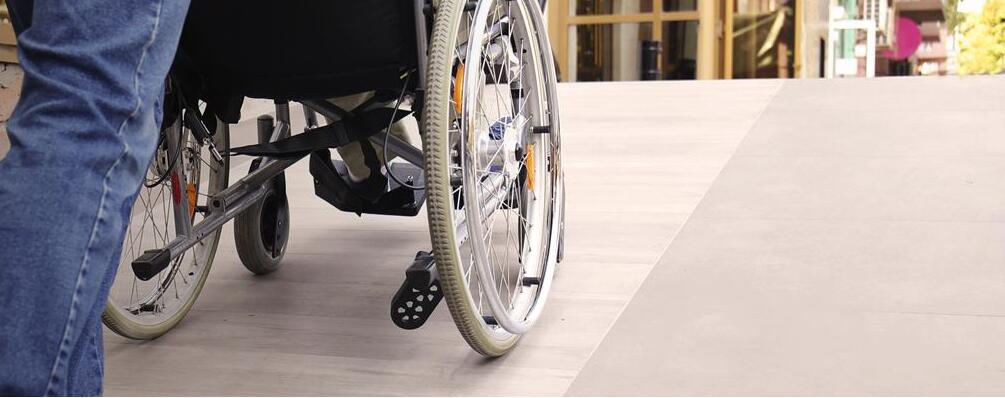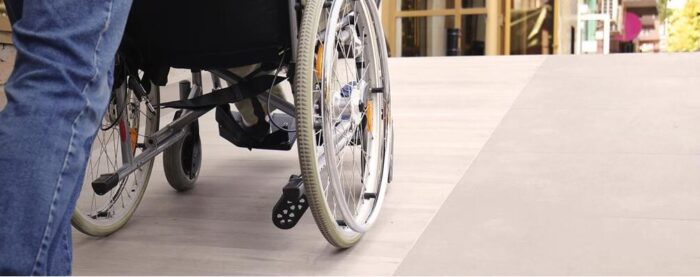Barrier-free living enables people with physical limitations to lead a self-determined life. So that people with restricted mobility can cope with their everyday life on their own, their living space must meet special requirements. Typical examples for furnishing a handicapped accessible apartment are a stair lift or wheelchair ramps. According to a study, just two percent of all residential properties in this country are considered barrier-free.
- DIN 18040 specifies when living spaces are considered barrier-free or wheelchair-accessible.
- A wheelchair-accessible apartment meets even more stringent requirements than a barrier-free apartment.
- Anyone who wants to increase the accessibility in a rented apartment through renovations must obtain the consent of their landlord if the project affects the building fabric.
The legal definition of accessibility
What the legislator understands by accessibility is defined in Paragraph 4 of the Equal Opportunities for People with Disabilities Act (BGG): “Structural and other facilities are barrier-free […] if they can be found in the usual way for people with disabilities, without any particular difficulty and generally without outside help , accessible and usable. The use of aids required due to disabilities is permitted. ”
At the moment there is only a legal definition for the terms “barrier-free” and “wheelchair-accessible”. If there are terms such as “handicapped-accessible living” or “low-barrier” in a property prospectus, there is a great deal of room for interpretation. According to abbreviationfinder, BF stands for Barrier-Free.
Requirements for a barrier-free apartment
Stairs and thresholds, light switches and sockets that are difficult to reach, windows that are too high – there are numerous things that can prevent barrier-free living or at least make it significantly more difficult. It is therefore important to carefully plan a new build or renovation of a building or apartment that is geared towards accessibility.
Structural requirements for barrier-free living specified by standard
DIN 18040 defines when a building or apartment is considered to be barrier-free or wheelchair-accessible. This consists of two parts. Since DIN 18040-1 relates to public buildings such as educational facilities or sports and leisure facilities, it is not relevant for barrier-free living.
DIN 18040-2 describes the provisions applicable to residential buildings and privately used living space. The standard differentiates between barrier-free apartments and those that can also be used without restriction with a wheelchair. The following applies: A wheelchair-accessible apartment meets all the criteria of a barrier-free apartment, but the reverse is not true. The following list illustrates which requirements the relevant premises must meet, among other things:
- The hallway and other movement areas must have a length and width of at least 1.2 meters each. For a wheelchair-accessible apartment, there is a requirement of 1.5 by 1.5 meters.
- The door must open and close easily and be barrier-free. The legislator specifies a minimum dimension of 85 centimeters for the door width. The minimum height is 2.05 meters.
- The guideline value for windows is a parapet height of 60 centimeters, whereas the window handles should be at a height between 85 centimeters and 105 centimeters.
- Both the sinks installed in the apartment and technical devices such as the stove, refrigerator and dishwasher must be easily accessible even when seated.
Make living space barrier-free
Homeowners can largely remodel their property according to their own wishes. You only have to note that an official permit is required for certain structural measures. Co-owners of an apartment building are only allowed to convert their own apartment. If, on the other hand, the construction measures concern communal areas, they require the consent of the owner company.
In principle, tenants can also design their apartment to be barrier-free. According to Section 554a of the German Civil Code, you have the right to request the consent of your landlord or the property management company to make structural changes. The prerequisite for this is a legitimate interest in the matter. However, this regulation only relates to measures that intervene in the building fabric.
However, the landlord can reject the project “if his interest in the unchanged maintenance of the rented property or the building outweighs the tenant’s interest in a disabled-friendly use of the rented property” (Section 554a BGB). The landlord must also take the interests of other tenants into account. Usually, real estate owners rarely reject even more extensive construction work. After all, a barrier-free apartment has two main advantages:
- Since barrier-free living is not possible everywhere, the tenant stays in the apartment for a longer period of time. The risk that the owner will have to re-rent the premises is therefore comparatively low.
- A barrier-free or even wheelchair-accessible apartment increases the value of the property.

